Satin Dresses: Timeless Elegance and Modern Versatility
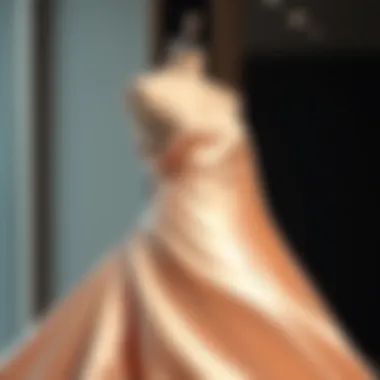
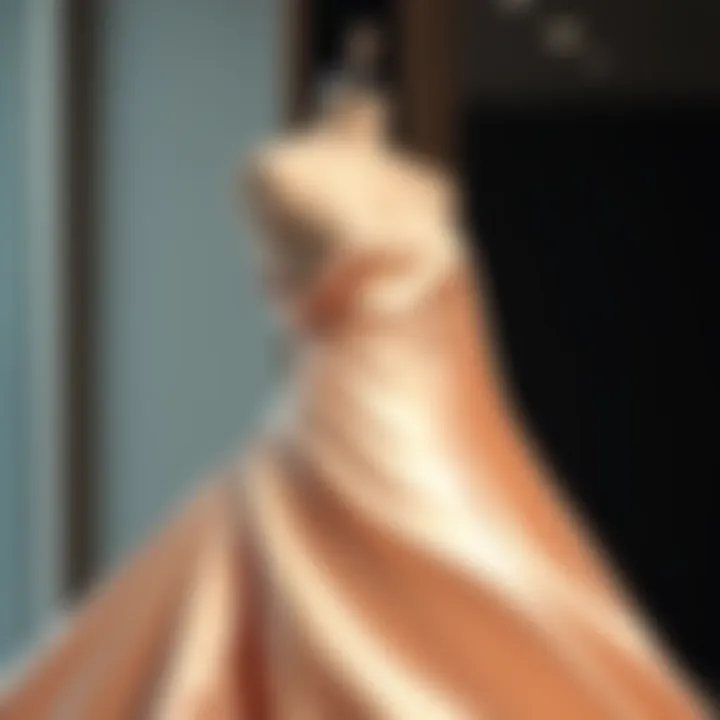
Intro
Satin material dresses possess a unique charm that weaves together elegance and functionality in ways that many fabrics can't replicate. When you think of satin, visions of glamorous evenings and sophisticated affairs might spring to mind. However, the versatility of satin dresses transcends just formal events. Their smooth texture and lustrous finish can be adapted to various styles and settings, making them a wardrobe staple.
Throughout history, satin’s appeal has fluctuated with trends and cultural movements. Originally reserved for royalty and the elite, this fabric has crafted its identity by embracing change. From the ballrooms of yesteryear to contemporary fashion runways, satin continues to adapt, ensuring it remains relevant across generations of fashion enthusiasts.
This article sets out to explore satin dresses in depth. From highlighting current fashion trends to giving practical advice on style and care, we aim to equip you with knowledge that enhances your sartorial choices. Let’s dive into the enchanting world of satin and discover its many facets.
Understanding Satin Material
Satin fabric, with its soft sheen and luxurious feel, forms an integral part of fashion. It embodies elegance and versatility, appealing to a wide range of users from high-end designers to everyday wear enthusiasts. To truly appreciate the splendor of satin dresses, it’s crucial to first grasp what satin material embodies. Understanding satin involves looking at its definition, characteristics, and how it compares to other fabrics, offering insights that can influence styling decisions.
Definition and Characteristics
Satin is not a fiber, but rather a type of weave that creates a fabric with a smooth front side and a duller back side. This unique construction gives satin its characteristic shine, making it popular for evening wear and special events. Its soft texture feels sublime against the skin, which adds to the overall comfort when donned.
The fabric boasts several features:
- Lustrous Finish: This shine can vary based on the type of satin used, adding an air of sophistication.
- Fluid Drape: Satin flows beautifully, allowing the garment to move gracefully, enhancing the silhouette of the wearer.
- Magnetic Touch: The soft texture is inviting and comfortable to wear, providing a sense of luxury.
"Satin's appeal lies not just in its look, but also in how it feels on the skin; it's a touch of luxury that speaks volumes."
Comparison with Other Fabrics
When considering satin material, it’s helpful to understand how it stacks against other fabrics. Three common textiles that often come up are silk, polyester, and chiffon. Each has its merits and challenges, which can impact decision-making in design and wear.
Silk
Silk is often seen as the gold standard in luxurious fabrics. It is naturally soft and breathable, making it a favorite for high-end fashion. The key characteristic of silk is its glossy surface, which creates an exquisite visual appeal. One benefit of silk is its ability to regulate temperature, making it suitable across seasons. However, it can be quite delicate and prone to wear, requiring careful handling.
Polyester
On the other hand, polyester is a synthetic fabric known for its durability and resistance to wrinkles. The key advantage of polyester in fashion is its affordability and ease of care. It tends to last longer and can mimic various textures, including satin. But, polyester often lacks the luxurious feel and breathability of its counterparts, possibly affecting comfort during wear.
Chiffon
Chiffon, with its light and airy nature, is often used in layers and overlays, complimenting satin nicely. While chiffon also has a soft texture, it is lighter and somewhat transparent. This makes chiffon an excellent choice for layering, giving designs a unique depth. However, it can be challenging to work with due to its delicate qualities, which may not hold up as well as satin in terms of structure.
Types of Satin
Familiarizing oneself with the different kinds of satin available adds another layer of understanding. There are several types, each with distinct traits. The most commonly recognized types include Double Satin, Single Satin, and Charmeuse.
Double Satin
Double satin features a fabric made with two sets of threads, allowing both sides to have a soft finish. This characteristic lends itself remarkably to garments needing a bit of structure while retaining a luxurious touch. It's heavy and drapes beautifully, making it preferable for evening gowns and formal wear. One downside can be its weight, which may not be suitable for all seasons or occasions.
Single Satin
Single satin, conversely, has a shiny face and a plain back. This makes it lighter and somewhat less expensive than double satin. It’s an excellent choice for those seeking elegance without the heavier fabric. However, it may not drape as fluidly, sometimes limiting the design potential in specific styles.
Charmeuse
Charmeuse is a lightweight satin, often made from silk or polyester. It combines the luxurious feel of silk with a more affordable price tag when made from synthetic fibers. The unique quality of charmeuse is the velvety texture, making it soft to the skin. Its disadvantage could be in durability, as it may snag easily on rough surfaces.
Understanding satin material sets the stage for a deeper appreciation of satin dresses. By grasping its definitions, characteristics, comparisons to different fabrics, and the variety found within satin types, one can make well-informed choices when it comes to design and wear.
Historical Context of Satin in Fashion
The history of satin is crucial in understanding the fabric's place in modern fashion. Satin isn't just a shiny material; it carries a legacy that reflects societal changes, cultural exchanges, and the evolution of taste. The roots of satin can be traced back to various times and places, illustrating how its appeal transcends mere aesthetics. With its unique draping qualities and luxurious sheen, satin has woven itself tightly into the fabric of fashion history. By exploring this context, one can comprehend why satin remains a staple in contemporary wardrobes.
Origins of Satin Fabric
Satin's origins are often linked back to the ancient city of Satinopolis, thought to be in China, where silk was king. The word "satin" itself hails from the Arabic "zaitun," referring to beautiful fabric procured from silkworms. Initially, satin was produced predominantly from silk, a process that required immense skill and craftsmanship. In its early days, satin was largely reserved for the elite, adorning the garments of royalty and leaders, establishing its reputation as a mark of status.
Evolution Through the Ages
As time marched on, satin took its rightful place in the outfits of various cultures. The fabric danced its way through the Renaissance, where it became synonymous with opulence and grace. The rich colors and luxurious feel made satin a favorite among nobility.
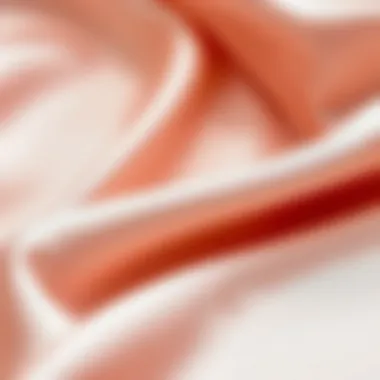
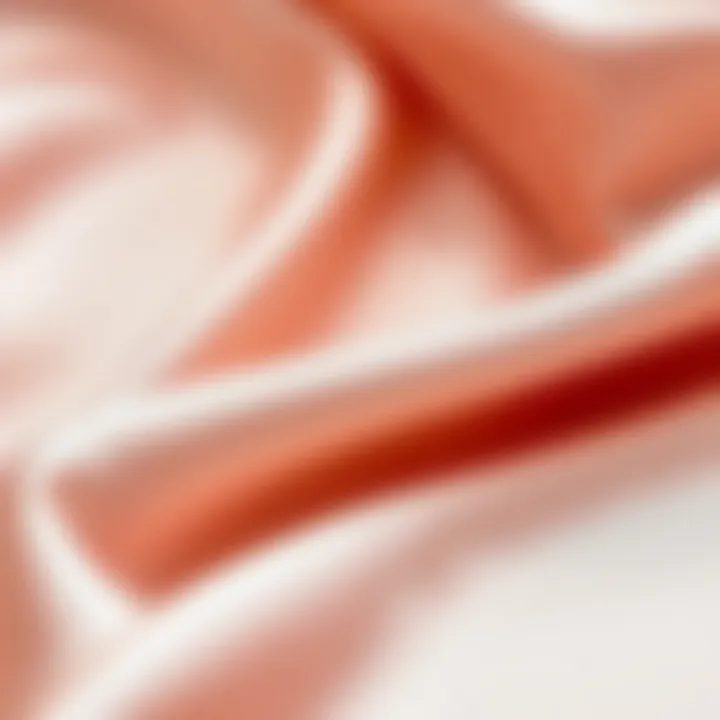
- 17th Century: Satin gained traction in Europe, with countries like France and Italy becoming centers for its production.
- Victorian Era: The textile’s adaptability made it a favorite for both formal gowns and stylish evening wear, allowing designers to play intricately with patterns and embellishments.
- 20th Century: With industrial advancements, satin saw an influx of synthetic alternatives, like polyester satin, making this once-exclusive fabric more accessible to the masses.
The fabric juggled roles: it adorned lavish ball gowns yet managed to fit into casual evening wear, illustrating its fluidity and versatility.
Cultural Significance
Satin is more than just a luxurious fabric; it holds significant cultural values globally. In some cultures, satin is intricately woven into traditions. For instance, in African nations, satin is often used in the form of kente cloth, symbolizing wealth and status during events like weddings and festivals.
In modern fashion, satin dresses symbolize a blend of tradition and contemporary style, embodying femininity and elegance. Its appearances on red carpets and high-fashion runways convey messages of confidence and sophistication.
Satin transcends generations, often acting as a bridge from past elegance to modern chic.
Satin’s historical significance reminds us of the journey it has traversed, allowing it to remain relevant in today’s ever-evolving fashion landscape.
Design Elements of Satin Dresses
The art of designing satin dresses lies in the harmonious interplay between fabric and form. Satin's smooth texture and gentle sheen grant designers a canvas where they can play around with various elements to create stunning silhouettes. Emphasizing design aspects is not merely about aesthetics, it’s crucial to understand how each element can influence the dress's overall appeal and wearability. For instance, the right silhouette can complement different body shapes, while the perfect neckline can highlight one’s features. This section delves into key design elements specific to satin dresses, unraveling their unique characteristics and how they can elevate one’s wardrobe.
Silhouettes and Cuts
A-Line
The A-Line silhouette is heralded for its versatility, making it an excellent choice for satin dresses. This design is characterized by a fitted waist that gradually flares out toward the hem, resembling the shape of a capital letter 'A'. The beauty of an A-Line dress lies in its ability to flatter various body types, offering a comfortable fit without compromising style. Moreover, this silhouette elegantly emphasizes curves without being overly tight. Notably, it can be worn by women of all sizes, making it a popular pick for many formal occasions, from weddings to galas. However, one must pay attention to the choice of length; a floor-length A-Line dress can exude elegance, while a tea-length variant might deliver a more playful vibe.
Mermaid
The Mermaid silhouette is celebrated for its eye-catching elegance. This style hugs the body closely from the bust through the hips before flaring out dramatically at the knees. The key allure of a Mermaid dress is its ability to enhance one’s natural curves, creating a sultry and sophisticated look. Ideal for formal events, this design makes a strong statement and is often the go-to for brides seeking a romantic choice. One of its unique features is the way it showcases the legs, adding an alluring touch. However, it’s worth noting that the snug fit can limit movement, which is a consideration for wearers who value comfort.
Ball Gown
Ball Gowns epitomize timeless elegance, making them a quintessential choice for formal settings. With their fitted bodices and voluminous skirts, they create a regal look perfect for events like proms or grand weddings. The standout feature of a Ball Gown is undoubtedly its dramatic skirt, often requiring layers of fabric to create the desired fullness. This majestic design allows for a variety of styles, from classic to contemporary, tailored to each individual's taste. Yet, with such grandeur comes the challenge of managing the volume; wearing a Ball Gown can be cumbersome if not styled correctly with the right accessories and footwear.
Necklines and Sleeves
Strapless
Strapless dresses can be a show-stopper, particularly when made from satin. The absence of straps draws attention to the neckline and collarbone, creating a beautiful frame for the face. This style is particularly beneficial as it allows for versatility concerning jewelry and hair. One major advantage is that it can be tailored to fit snugly, enhancing the wearer's silhouette without distraction. However, some find that without proper support, a strapless dress can slip or feel insecure, highlighting the emphasis on fit.
Off-the-Shoulder
The Off-the-Shoulder design conveys a sense of relaxed sophistication, showcasing the shoulders and collarbones elegantly. This neckline suits a variety of satin dresses, from casual to formal. One of its charms is the softness it brings, creating a romantic silhouette. However, similar to strapless designs, wearers need to consider their comfort level, as the neckline may require adjustments to prevent slipping. This style encourages an array of accessory pairings, allowing individuals to accessorize with statement earrings or layered necklaces, enhancing the overall look.
Long Sleeves
Long sleeves can transform a satin dress into a piece suitable for various occasions, enhancing its versatility. The elegance of a sleek arm coverage can be striking, especially when paired with a delicate satin finish. Sleeves can add an element of sophistication and warmth, particularly in colder months. However, one downside could be that they might not appeal to those who prefer freedom of movement, especially in crowded or warm settings.
Color Palette and Patterns
The color palette for satin dresses is wide-ranging, offering everything from deep jewel tones to soft pastels. This diversity allows individuals to make bold choices or subtle statements. Patterns can add character, but it’s essential they complement the inherent elegance of satin. With options like florals for a romantic feel or geometric patterns for a more modern vibe, one can curate a unique look. When choosing colors, considering skin tone is key; rich shades may enhance warmth, while cool tones could offer a refreshing touch. Patterns, on the other hand, can break the monotony, making a satin dress feel ultra-modern when styled correctly.
"Satin dresses offer more than just beauty; they possess the ability to enhance one's confidence and presence in any social gathering."
Understanding these intricate design elements can greatly influence one's choice and appreciation for satin dresses, ultimately leading to a more satisfying shopping experience.
Occasions for Wearing Satin Dresses
Satin dresses offer a breath of sophistication and luxury that makes them an ideal choice for a variety of events. Understanding the different occasions to showcase these stunning garments enhances their versatility in any wardrobe. This section will delve into several key occasions, from formal events to casual gatherings and seasonal styles, demonstrating how satin can transform a look. The fluid nature of satin not only complements different body types but also adapts beautifully to various settings, establishing its role as a staple in modern fashion.
Formal Events
Weddings
Weddings are a paramount event where the elegance of satin shines the brightest. Picture a bride adorned in a satin gown, the fabric draping gracefully against her silhouette. This fabric’s soft sheen reflects light in enchanting ways, making it a top choice for wedding dresses. Satin dresses allow for structure, and they hug the body while flowing delicately with movement—this characteristic underscores why satin is a popular choice. The only downside is that it might require careful handling to avoid damage, but the visuals they provide on such a significant day far weigh up any trouble.
Galas
Galas are another spectacle where satin dresses steal the spotlight. These occasions call for a majestic flair, and satin delivers with its luxurious feel. Wearing satin at a gala not only portrays a sense of refinement, but it also allows the wearer to stand out amid a sea of formal attire. The rich colors and textures available in satin add depth to the overall appearance. A potential concern, though, could lie in the ease of wrinkling, making pre-event preparations vital to ensure one looks their best while making a grand entrance.
Red Carpet
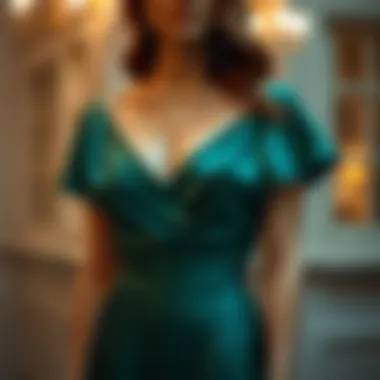

Red carpet events represent a pinnacle of fashion expression, and here, satin makes its mark substantially. Celebrities often gravitate towards satin due to its classic sophistication. The fabric flows dramatically, allowing for captivating movement on camera and adding an element of glamour to the proceedings. Satin’s ability to elevate a look means it remains in favor on such prestigious occasions. However, tailored fittings are crucial since even the tiniest misfit can draw unintentional attention, diverting from the intended elegance.
Casual Gatherings
Brunches
Brunches mark a delightful social occasion, often characterized by a relaxed ambiance. While it may seem unconventional, satin can absolutely shine here as well, offering an effortless yet chic vibe. Wearing a satin dress to brunch adds a touch of sophistication without overwhelming the casual nature of the gathering. The soft texture makes for comfortable attire during leisurely meals. One consideration, though, is that the dress might feel warm in hotter weather, so lighter styles or combinations with summery jackets could be considered.
Beach Parties
Beach parties usually lend themselves to lighter fabrics, but satin isn’t out of the game entirely. Opting for a satin cover-up or dress can impart elegance even on sandy shores. The key characteristic of a satin dress for beach gatherings is its ease of transitioning from day to evening. However, one should be mindful of potential challenges on windy days, where the fabric's weight may turn playful breezes into fashion faux pas.
Evening Cocktails
Satin dresses have an allure that perfectly complements the glamour of evening cocktails. When you stroll into a cocktail gathering draped in a satin number, you naturally exude confidence. The versatility allows for various styles and colors, be it sleek and straight or flirty and ruffled. The potential downside could be that one might compete with the bold colors often seen at these events. However, a well-chosen soft hue can stand out beautifully against a backdrop of vibrant evening lights.
Seasonal Adaptations
Summer Styles
Summer brings the opportunity to flaunt satin dresses in breezy, fashion-forward styles. Lightweight and often flowing, satin gowns provide comfort during warm evenings while embodying elegance. The shimmering quality of satin fits perfectly with the sun’s rays, enhancing any summertime festivities. A downside to summer satin, however, is how quickly it can heat up in direct sunlight, so opting for dresses with breathable designs becomes vital.
Winter Layers
Winter layers present a unique challenge, yet satin dresses can be artfully integrated into seasonal wardrobes. Pairing satin dresses with stylish outerwear lays the foundation for fashion-forward winter ensembles. A satin dress’s visually striking appearance can brighten up dreary winter days; however, layering properly is essential to avoid the cold winter air. Heavy fabric combinations or cozy wraps can make all the difference, allowing one to don satin while staying warm.
Autumn Trends
Autumn leads to a new realm of styles, where rich, jewel-toned satin dresses can truly shine. The depth of colors available in satin complements the warm hues of fall foliage. As the temperatures dip, satin pairs wonderfully with boots or heavier accessories. Although this season often celebrates layering, satin dresses remain a popular choice thanks to their adaptability and elegance. But there might be a tendency for satin to show static cling, requiring careful garment care during this transitioning season.
Satin dresses are more than just a piece of clothing; they encapsulate moments and memories unique to each occasion.
Accessorizing Satin Dresses
Accessorizing satin dresses effectively can elevate an entire outfit and transform it from simple to stunning. The right accessories not only complement the luxurious feel of satin but also add personality and flair to the overall look. Emphasizing the synergy between the dress and its adornments is crucial; a well-placed addition can enhance elegance, while a poorly matched accessory might bring it all down. In this section, we will discuss footwear, jewelry, and bags – all pivotal in achieving a harmonious look when donning satin.
Footwear Choices
Heels
Heels often carry a certain je ne sais quoi that elevates the aesthetic of satin dresses to new heights. By adding a few inches, they facilitate a longer leg-line, which is often aesthetically pleasing. Their key characteristic—elevated posture—enables a graceful demeanor that aligns well with the fluidity of satin. In terms of benefits, heels frequently seize the spotlight for formal occasions. However, they can also present drawbacks, such as discomfort during extended wear. The unique structure of heels is particularly advantageous for showcasing the dress's hemline, drawing eyes downward to admire the outfit as a whole. They may also prove risky on uneven surfaces, where stability becomes a concern.
Flats
Flats present a compelling alternative, especially for casual or relaxed gatherings. Their primary attribute is comfort, allowing for more extended wear without the discomfort that may accompany heels. As a practical choice, flats can provide ease of movement, making them ideal for brunches or light outings. Unlike heels, they don't necessitate balancing or precise navigation. That said, they may lack the elongating effect of heels, potentially affecting the overall silhouette when paired with a satin dress. It's essential to choose flats with a refined design to maintain elegance while benefiting from comfort.
Boots
Boots can break the mold with satin dresses, presenting an opportunity to infuse a bit of edge into a traditionally delicate fabric. Ankle boots, for instance, can juxtapose the elegance of satin, offering a modern twist, particularly during colder seasons. The distinctive trait of boots—versatility—enables them to transition from casual to more formal environments. While they can project an assertive fashion statement, boots may not always align with the soft and flowing nature of satin. However, with the right pairing and thoughtful selections, they can create a visually striking contrast that highlights both the material's elegance and its adaptability to various styles.
Jewelry Considerations
Earrings
When accessorizing a satin dress, earrings can serve as the perfect enhancement. Their delicate sparkle draws attention to the face and often elevates the ensemble. The ability to choose from various designs—from dangling chandeliers to understated studs—allows for versatility in styling. However, overdoing it with heavy or gaudy pieces can overwhelm the dress's elegance. Simple yet striking earrings keep the look polished without detracting from the fabric's luxurious nature.
Necklaces
Necklaces can either accentuate or clash with the neckline of a satin dress. Depending on the cut, a well-placed pendant can highlight this area, adding a subtle yet effective focal point. Statement necklaces may stand out beautifully with strapless designs, while high-necked satin pieces might suit more minimalistic styles. Ensuring the necklace is proportionate to the dress is essential; too ornate can overshadow sophistication, while too simple may miss the mark entirely. A balanced approach is crucial to pulling off a cohesive look.
Bracelets
Lastly, bracelets can be the unsung heroes of accessorizing. Wrapping your wrist in a delicate band or a stack of bangles can create an interesting visual narrative with satin. They add a bit of shine but should be chosen with care to avoid clashing with other jewelry. Dainty designs can contribute softness while bold pieces can create a striking contrast. When considering bracelets, think about sleeve length and any other accessories to maintain harmony.
Bags and Clutches
Bags and clutches play an essential role in the accessorization puzzle, serving both functionality and style. Opting for a clutch adds an element of night-time elegance, making it ideal for formal events. The practicality of a handbag, on the other hand, offers versatility for day-to-day or casual encounters.
Choosing colors or textures that resonate with the satin dress can enhance the overall style—even introducing contrasting hues, if done tastefully. A soft, pastel hue might resonate with delicate satin, while bolder colors can make a statement, especially with the right pairing. Be mindful to select one with a sleek silhouette to echo the refined nature of satin and preserve the garment’s flow.
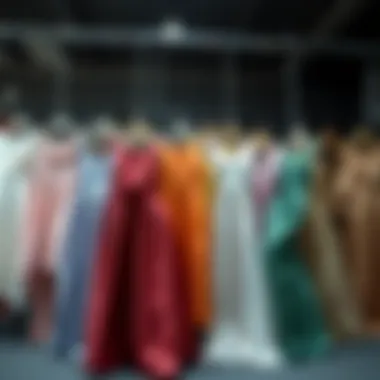
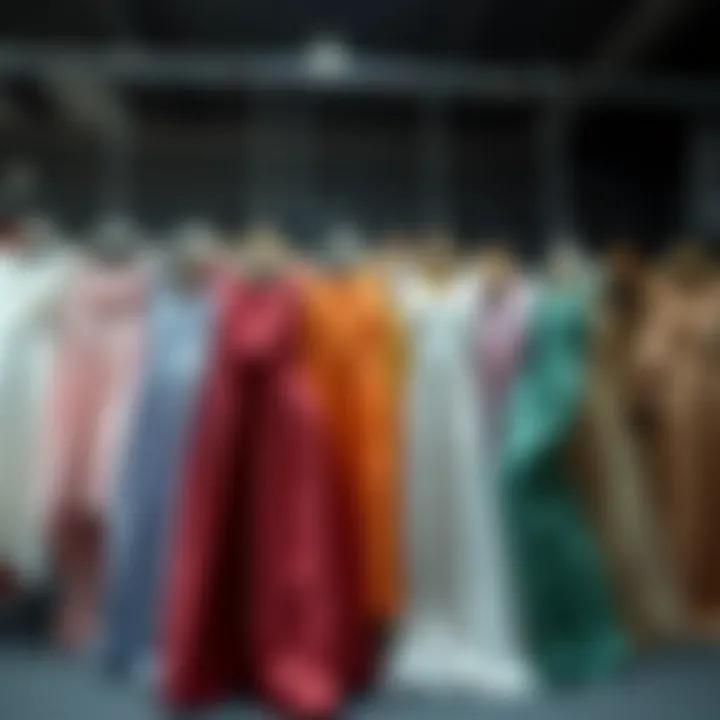
Choosing the right accessories is an art, one that requires intuition and thoughtfulness. Striking the perfect balance can be challenging, but understanding how to mix these elements can dramatically enhance the way a satin dress is perceived, making the wearer feel truly elegant.
Care Techniques for Satin Dresses
Taking proper care of satin dresses is essential for maintaining their beauty and longevity. Satin is a delicate fabric that can easily lose its charm if not treated with the utmost consideration. Understanding the nuances of washing, storing, and stain removal helps to protect these exquisite garments, ensuring they remain as stunning as the day they were purchased.
Washing Instructions
Hand Wash vs. Machine Wash
When it comes to washing satin dresses, the debate between hand washing and machine washing is one that many enthusiasts face.
Hand washing is often seen as the gentler option. By using cool water and a mild detergent, you can delicately cleanse the fabric without the risk of agitation from a machine. This method also offers the chance to focus on problem areas like stains without aggravating the entire garment. However, it can be time-consuming and requires a careful touch to avoid twisting or stretching the material.
In contrast, machine washing can be quick and efficient. It’s best to select a gentle cycle and place the dress in a mesh garment bag to protect it from potential damage. Here, the key characteristic is speed, making it a popular choice for those who prefer a less hands-on approach. However, many still debate about the wear and tear machine washing may cause over time, which could lead to fabric fraying or loss of sheen.
Ultimately, the choice depends on individual comfort and the specific care instructions for the satin fabric.
Dry Cleaning
Dry cleaning is often recommended for satin dresses, especially those that are embellished or have intricate designs. This method uses solvents instead of water, preventing the risk of water marks or shrinkage that can arise from washing. The standout characteristic of dry cleaning is its ability to preserve the intricate details and hues of satin.
While it’s commonly viewed as the safest means of cleaning for delicate fabrics, dry cleaning can be costly and necessitates trips to the cleaners. This can be a disadvantage for those who wish to expedite the process. However, many designers suggest that a professional cleaning retains the dress's pristine qualities without compromising its elegance or fit over time.
Storage Tips
Hanging vs Folding
When it comes to storage, hanging satin dresses is generally the better approach. Using padded hangers can help maintain the shape of the dress, preventing creases that folding may cause. Hanging also allows the fabric to breathe, reducing the likelihood of developing odors.
Folding, while space-efficient, poses risks like permanent creases and can lead to wrinkles that are harder to remove. However, if one chooses to fold, using acid-free tissue paper between layers can help mitigate some of these issues. Each method has its unique features, but hanging is usually favored to ensure the garment keeps its elegant silhouette.
Avoiding Color Fading
Satin’s brilliant hues can fade over time if not stored correctly. Avoidance of light exposure is crucial, as UV rays can dull those vibrant colors, especially for bold shades. This care practice can significantly extend the life of your dress’s original tone.
Keeping satin dresses in a cool, dark place where it stays away from direct sunlight can be beneficial. Many suggest using garment bags to provide additional protection. This minor effort can make a major difference in preserving the striking visual appeal of satin dresses for future occasions.
Dealing with Stains
Stains are often the bane of satin dress ownership, given the fabric's sensitive nature. Quick action is fundamental here; the sooner you treat a stain, the better the chances of removal. It’s advisable to dab at the stain with a clean cloth rather than rubbing, as this keeps the stain from spreading.
Common stains like red wine or makeup can be especially troublesome, but solutions such as gentle detergent or specialized fabric cleaners can be lifesavers. Keeping a stain removal stick handy can also be quite practical for minor mishaps. Just remember, always conduct a patch test before applying any treatment all over your satin dress to prevent unexpected damage.
The Future of Satin Fashion
As we look towards the horizon of fashion, satin dresses are carving a unique niche that reflects both elegance and functionality. The importance of discussing the future of satin fashion lies in its adaptability to modern sensibilities, particularly in sustainability and technological advancements. Consumers now seek not just beauty in their attire but also a sense of responsibility and innovation. This section will dive into sustainable practices and innovative designs, shedding light on how satin can evolve while remaining a cherished fabric in wardrobes.
Sustainable Practices
Ethical Sourcing
Ethical sourcing is about ensuring the materials used in production come from responsible and sustainable processes. In the realm of satin dresses, ethical sourcing promotes the use of eco-friendly materials that minimize environmental impact. This contributes to the overall topic of satin fashion by aligning with growing consumer preferences for transparency and sustainability in fashion.
The key characteristic of ethical sourcing is its dedication to fair labor practices. Choosing fabrics that are certified fair trade or produced under ethically responsible conditions allows consumers to make conscious choices. This aspect resonates deeply with fashion enthusiasts who want to feel good about what they wear.
The unique feature of ethical sourcing often involves local production, which not only supports local economies but also reduces transportation emissions. However, it can sometimes lead to higher price points for consumers, presenting a trade-off between cost and conscious consumption.
Recycling Options
Recycling options are essential as the fashion industry faces an ever-growing waste problem. In terms of satin, recycling can include repurposing old satin garments into new creations or using recycled materials to produce new satin fabric. This practice encourages a circular economy and contributes to sustainability goals in fashion.
Recycling options' key characteristic is their ability to lessen the burden on landfills while reducing the need for virgin materials. For a discerning audience, this not only speaks to environmental responsibility but also supports unique, one-of-a-kind designs that can emerge from repurposed materials.
However, a challenge arises with color retention and quality when recycling. Often, garments made from recycled materials may not hold the same lustrous appearance as their original counterparts. Nevertheless, brands are continually innovating approaches to overcome these obstacles and improve the quality of recycled satin.
Innovative Design Trends
Tech-Integrated Fabrics
As technology permeates various aspects of our lives, the integration of tech into fashion is no exception. Tech-integrated fabrics bring forth the potential for satin to become more than just a beautiful surface; these fabrics can incorporate features such as temperature regulation or moisture-wicking properties. This transition not only enhances the user experience but also opens avenues for new creative expressions.
The key characteristic of tech-integrated fabrics is their ability to enhance the functionality of traditional satin. For instance, a satin dress that adjusts to the wearer's body temperature could lead to unparalleled comfort during various seasons. This versatility makes tech-integrated satin a popular choice among forward-thinking designers and consumers alike.
Yet, there are considerations that come with tech-integrated fabrics, such as care requirements. The complexity of maintaining such garments can deter some users who prefer low-maintenance options.
Customizable Styles
The trend towards customization reflects the desire for individuality in fashion. Customizable styles in satin dresses allow consumers to choose specifics ranging from fabric patterns to cut preferences, thus personalizing their look to reflect their unique identity. This move towards bespoke fashion is not just a trend; it signifies a deeper connection between the consumer and the items they purchase.
The key characteristic of customizable styles is their focus on consumer engagement, as brands increasingly offer platforms for personalized options. By fostering this relationship, brands may enjoy greater loyalty, as individuals feel their garments accurately symbolize their personality.
However, one ought to consider the delays in order fulfillment when opting for customization. Production may take longer due to the additional processes involved, posing a challenge for those seeking clothing for immediate occasions.
Market Insights
The future of satin fashion is also anchored in market insights that reveal shifting consumer behaviors and industry trends. Analysts are observing a steady increase in demand for satin dresses that cater to both casual and formal settings. The versatility of satin positions it well in the evolving market landscape, bolstered by a renewed interest in sustainable and ethical practices among consumers.
"The journey of satin in the fashion world is both historical and forward-thinking, crafting pathways to innovation while respecting the elegance it embodies.''
The exploration of satin's future is essential for designers, retailers, and fashion enthusiasts who wish to stay ahead in this ever-changing landscape.



